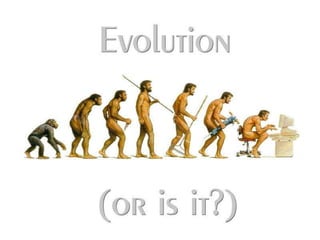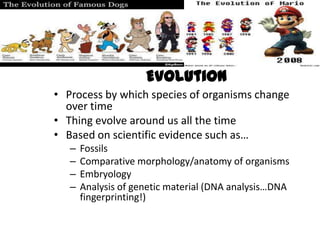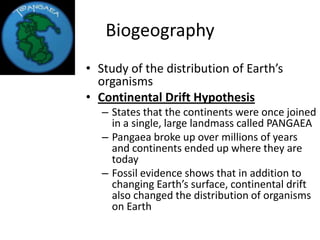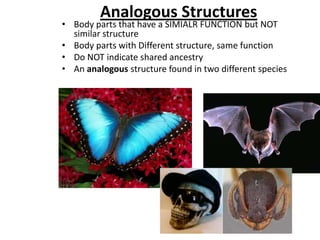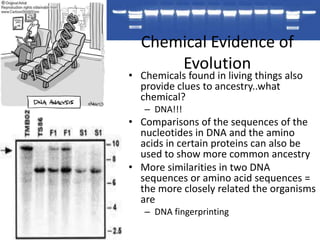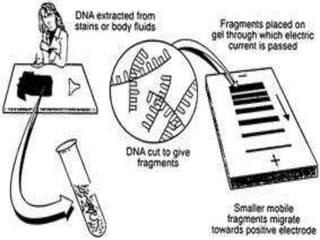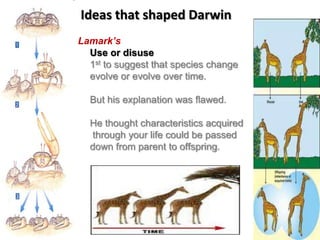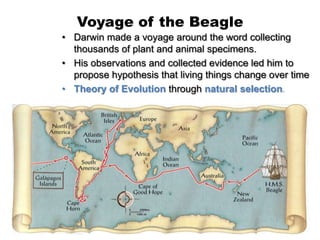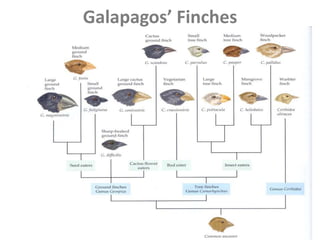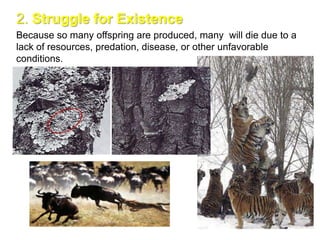Evolution part 2
- 2. Evolution • Process by which species of organisms change over time • Thing evolve around us all the time • Based on scientific evidence such as… – Fossils – Comparative morphology/anatomy of organisms – Embryology – Analysis of genetic material (DNA analysis…DNA fingerprinting!)
- 3. Terms to Know • Species – a group of organisms that share similar characteristics and can interbreed to produce fertile offspring – As species EVOLVE, they produce new traits and lose other traits…. • Adaptation – Any physical or behavioral trait that improves an organisms chance for survival and reproduction
- 4. Fossil Evidence for • Fossils: Evolution – Remains or evidence of organisms that have lived in the past – Provided clues of when different species lived • Law of Superposition – States that in undisturbed sedimentary rock, older rock layers lie beneath younger rock layers – By Identifying the fossils indifferent layers of rock and applying the law of superposition, scientists can determine: • when the certain organisms lived • The order in which things evolved
- 7. Biogeography • Study of the distribution of Earth’s organisms • Continental Drift Hypothesis – States that the continents were once joined in a single, large landmass called PANGAEA – Pangaea broke up over millions of years and continents ended up where they are today – Fossil evidence shows that in addition to changing Earth’s surface, continental drift also changed the distribution of organisms on Earth
- 9. Comparative Anatomy/Morphology • Do other organisms have arms like us? • Many species share similar structures.. • Do flamingos and blue jays have feathers? – Yes…the presence of feathers suggest that both groups of birds descended from an animal with feathers – Flamingos and blue jays are more closely related than either one is to an animal without feathers (like us)
- 10. Homologous • Structures Body parts of different organisms that have similar structure but NOT similar FUNCTION • Homologous structures DO indicate shared ancestor
- 11. Analogous Structures • Body parts that have a SIMIALR FUNCTION but NOT similar structure • Body parts with Different structure, same function • Do NOT indicate shared ancestry • An analogous structure found in two different species
- 14. Homologous vs. Analogous Structures • Homologous= Same structure, DIFFERENT Function • Analogous= Different Structure, SAME Function
- 15. Comparativethat are similar Anatomical features Anatomy in structure are called homologous structures, and they indicate common ancestry.
- 16. Vestigial Structures • Structures that do not seem to play a role in the body functions of the organism – Appendix • Rats digestion • Humans no use…appendix is a vestigial structure • It can be concluded that the common ancestor of the human and rat had an appendix
- 17. Embryology • Study of embryos • Embryo early stage in the development of an organism • Scientists compare the development of the embryos of different species • Similarities in development =shared ancestor • More traits in common=more closely related Modern Organisms EVOLVED from COMMON Ancestors in an Evolutionary Chain
- 19. Chemical Evidence of Evolution • Chemicals found in living things also provide clues to ancestry..what chemical? – DNA!!! • Comparisons of the sequences of the nucleotides in DNA and the amino acids in certain proteins can also be used to show more common ancestry • More similarities in two DNA sequences or amino acid sequences = the more closely related the organisms are – DNA fingerprinting
- 21. ALL organisms have DNA made up of the same Amino Acids… The only thing that’s different is the ARRANGEMENT/sequence of amino acids… The More similar AA sequences= the more closely related the organisms are!
- 22. Similarities in Molecular Biology Common amino acid sequences suggest an evolutionary relationships between various species of organisms.
- 23. Observed Evolutionary Change • Speciation – Evolution of a new species from an existing species • Occurs when a population is separated into groups that cannot reach each other to interbreed • Once groups are separated, environmental conditions in each area influence which traits are helpful or harmful to members of each population – Less helpful traits disappear – Helpful traits become more popular • Overtime, these changes can produce 2 distinct species that can no longer interbreed
- 27. Two Ways Evolution is believed to have Occurred • Gradualism – Evolution occurring over a long period of time – Slow and constant change – Small difference between generations – This is how Darwin believed NATURAL SELECTION worked • Punctuated Equilibrium – Evolution occurs in spurts – Changes occur rapidly followed by long period without change – Causes: • random mutations in DNA • Sudden Major changes in environment
- 28. Microevolution • When evolution occurs quickly enough for scientists to observe • Bacteria – Reproduce rapidly – Trait for Resistance to antibiotics is passed down to offspring – This is how bacteria become resistant to certain medicines…NOT GOOD
- 29. Convergent evolution • organisms that descended from different ancestors • Evolve similar anatomies and/ or behaviors if they live in similar environments
- 30. • Organisms from the Divergent same ancestor have developed different Evolution anatomies/behavior s (and eventually form new species) • Environment influences their new anatomy/behaviors
- 31. Darwin’s Theory of Evolution by Natural Selection
- 32. Ideas that shaped Darwin – Before Darwin people believed Earth was less than 10,000 years old and also relatively unchanged • Buffon- Studied the fossil record which showed that the Earth might be much older.(4.3 and 4.5 billion years old) • Hutton - Layers of rock are moved by forces beneath Earth’s surface. Most geological processes operate extremely slowly. • Lyell - geologic process that shaped the Earth in the past still continue today.
- 33. Ideas that shaped Darwin Before Darwin people believed that species were fixed, plants and animals had always been the way they are today Cuvier – based fossils from different rock layers gave evidence that organisms from the past differed greatly from living species
- 34. Ideas that shaped Darwin Lamark’s Use or disuse 1st to suggest that species change evolve or evolve over time. But his explanation was flawed. He thought characteristics acquired through your life could be passed down from parent to offspring.
- 37. • Malthus – suggested that if the human population continued to grow unchecked, eventually there wouldn’t be enough food and living space for everyone.
- 38. • As Malthus predicted, world population growth is exponential: • 1 billion in 1830 • 2 billion in 1930 • 3 billion in 1960 • 4 billion in 1974 • 5 billion in 1987 • 6 billion in 1999 • 7 billion in 2013 • 8 billion in 2028 • 9 billion in 2048
- 39. Voyage of the Beagle • Darwin made a voyage around the word collecting thousands of plant and animal specimens. • His observations and collected evidence led him to propose hypothesis that living things change over time • Theory of Evolution through natural selection.
- 40. Voyage of the Beagle • Darwin noticed that plants and animals on the Galapagos islands of the coast of Ecuador were different from those on the mainland and also from island to island
- 41. Neck-size vs. Vegetation height
- 44. Darwin’s Theory • In 1859, Darwin published a book titled, • “On the Origin of Species” • In this book he presented all the evidence he had gathered over the past several years supporting his theory that evolution has been taking place for millions of years—and continues in all living things. • In his book he also proposed a mechanism for evolution called • Natural Selection
- 45. Summary of Evolution • DNA is the blue-print for building ALL living things on planet Earth. • DNA sequences are changed by: • random mutations • Radiation • Viruses • Chemicals • sexual reproduction • Migration • geological events • As a result there is variation within populations of a species. • Those individuals of a particular species with a phenotype (as a result of their genotype) that is more fit to survive in a given environment has a better chance to reproduce. • Those individuals who reproduce more pass-on their genes at a higher frequency than those who do not. • EVERYTHING is trying to SURVIVE and REPRODUCE
- 46. NATURAL SELECTION The ability of an organism to survive and reproduce in its specific environment is called fitness. • Individuals with characteristics that are not well suited to their environment either die or leave few offspring • Individuals that are better suited to their environment survive and reproduce most successfully. • Darwin called this process Survival of the Fittest, or Natural Selection.
- 47. 4 Principles of Natural Selection • Variation • Competition • Excess offspring • Survival of the Fittest
- 48. 4 Main Principles of Natural Selection 1. Variation exists within a population 2. Organisms compete for limited resources 3. Organisms produce more offspring than can actually survive 4. Individuals with variations suitable for their habitat are the ones that SURVIVE and REPRODUCE
- 49. • Three species of lizard. • B- The ones at the bottom live in the shrubland, and are colored to blend in. •The top pictures show the same species of lizard, but the variety that lives in the White Sands •They all evolved to become white (camouflage) •The DNA on the bottom shows the location of the mutation that gives the white color
- 50. 1. Inherited Variation Individual organisms within the population differ. Most of this variation is determined by genetic inheritance (recombination), but sometimes it is the result of genetic mutations.
- 51. 2. Struggle for Existence Because so many offspring are produced, many will die due to a lack of resources, predation, disease, or other unfavorable conditions.
- 52. 3. Overproduction of Offspring Organisms produce more offspring than can survive. Many of the offspring do not survive to reproductive age.
- 53. 4. Differential Reproduction Individuals best suited to their environment survive and reproduce most successfully. Therefore these organisms pass their advantageous traits to their offspring while offspring with disadvantageous traits die or produce fewer offspring.
- 54. Descent with Modification • Natural selection causes species to change over time. • Species alive today descended with modification from ancestral species.
- 55. Evolution of populations • Genetic Drift • Sometime changes in the allele frequency within a population occur by chance. This is called genetic drift. Before After • The genes of the next generation will be the genes of the “lucky” individuals, not necessarily the healthier or “better adapted” individuals.
- 56. Gene Flow • genes from one population are introduced into the gene pool of another population – Gene Pool: the combined genetic information of ALL members of a population – Biggest Factor that Effects Gene Flow: MOBILITY For example: The immigration and emigration of organisms. The dispersal of seeds or spores.
Editor's Notes
- The fact that this process of making proteins is common to all living things suggests that it has been passed down from an ancient ancestor.Ask students to share their interpretations of the data table.
- The genes of the next generation will be the genes of the “lucky” individuals, not necessarily the healthier or “better adapted” individuals. That, in a nutshell, is genetic drift.
